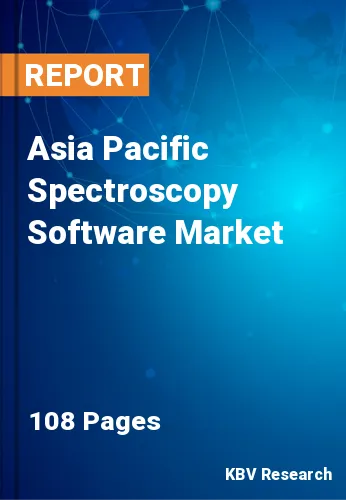The Asia Pacific Spectroscopy Software Market would witness market growth of 10.0% CAGR during the forecast period (2023-2030).
The need for environmental monitoring and compliance has grown significantly. Governments and regulatory bodies enforce stricter pollution control rules, necessitating spectroscopy software to assess and address environmental issues. Spectroscopy software is essential to medicine for several purposes, such as drug development, medical research, illness detection and therapy. As emerging economies grow and develop, there is an increasing demand for analytical instruments and software. The continuous development of spectroscopy instruments with enhanced capabilities, sensitivity, and ease of use has fueled the adoption of associated software.
Furthermore, integrating artificial intelligence (AI) and machine learning (ML) into spectroscopy software is gaining traction. These technologies enhance data analysis, automate processes, and improve the accuracy and speed of results interpretation. Developing compact and portable spectroscopy instruments has made the technology more accessible across various industries. This trend facilitates on-site analysis and real-time monitoring. The trend towards remote access and cloud-based solutions is on the rise. Researchers and analysts can access and process data from anywhere, improving collaboration and sharing.
Countries like India and China often experience severe air quality issues due to their reliance on coal for energy. The Asia Pacific region significantly contributes to global greenhouse gas emissions. China, in particular, is one of the largest emitters of carbon dioxide. As a result, the region plays a crucial role in global climate change. Many countries in the Asia Pacific region face water scarcity issues, and energy production often consumes large amounts of water. Hydropower, for example, can lead to conflicts over water resources and negatively impact local ecosystems.
Additionally, as per the data from the Energy Information Administration, in 2021, India ranked as the world's third-largest energy consumer, following China and the United States. The demand for crude oil in 2021 rose by 5%, reaching 4.7 million b/d, driven by the recovery of India's economy to pre-pandemic levels. In 2021, diesel constituted India's largest share of petroleum product consumption, amounting to 35%. Therefore, rising environmental concerns due to coal and fossil fuel consumption in countries like China and India will increase the need for environmental testing, subsequently increasing the demand for spectroscopy software in the Asia Pacific region.
The China market dominated the Asia Pacific Spectroscopy Software Market, By Country in 2022, and would continue to be a dominant market till 2030; thereby, achieving a market value of $138.7 million by 2030. The Japan market is exhibiting a CAGR of 9.2% during (2023 - 2030). Additionally, The India market would experience a CAGR of 10.7% during (2023 - 2030).
Based on Deployment Mode, the market is segmented into On-premise, and Cloud. Based on Application, the market is segmented into Food Testing, and Environmental Testing. Based on countries, the market is segmented into China, Japan, India, South Korea, Singapore, Malaysia, and Rest of Asia Pacific.
Free Valuable Insights: The Global Spectroscopy Software Market is Predict to reach USD 1.8 Billion by 2030, at a CAGR of 9.1%
The market research report covers the analysis of key stake holders of the market. Key companies profiled in the report include Danaher Corporation, Thermo Fisher Scientific Inc., Shimadzu Corporation, Genedata AG, Waters Corporation, ABB Group, Agilent Technologies, Inc., SpectralWorks Ltd., Bruker Corporation, and Lablicate GmbH.
By Deployment Mode
By Application
By Country
Our team of dedicated experts can provide you with attractive expansion opportunities for your business.

